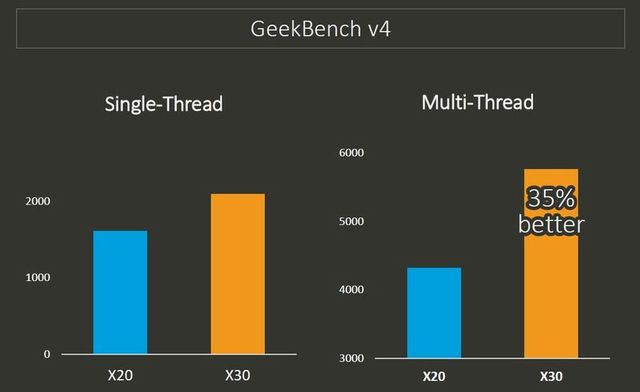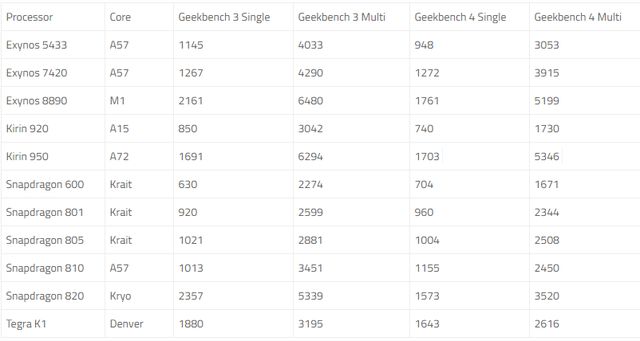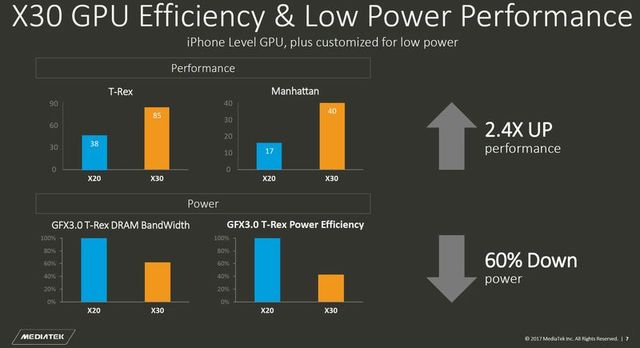Review Helio X30: benchmarks results Geekbench 4, GFX 3.0 T-Rex and comparison with Helio X20
Helio X30 processor is the future flagship of MediaTek
Mobile processors manufacturers, like smartphone manufacturers, also have flagship, middle-class and budget models. The main revenue is brought by budget models, because they are sold most of all. But consumers are of course interested in the flagships, because these are the newest technologies, peak performance and something abstruse-interesting from the world of technological haute couture.
MediaTek, which is striving to be on the same level with the leader of market Qualcomm, is actively promoting its flagship processor Helio X30. Today we review new processor and look at its performance.
MediaTek Helio X30 specifications:
- Model: Helio X30
- Model Number: MT6799
- The composition of cores: three clusters, the upper cluster – 2 cores Cortex-A73 at 2.5 GHz, the middle cluster – 4 cores Cortex-A53 at 2.2 GHz, the lower cluster – 4 cores Cortex-A35 at 1.9 GHz
- Technological Process: 10nm FinFET + from TSMC
- Graphics: PowerVR 7400XT MP4 800MHz
- Memory: LPDDR4X dual-channel, frequency 1866MHz (933MHz per channel),
- Bit instructions: 64bit, ARMv8-A
- Category LTE: LTE Cat.10 – Download speed up to 450Mbit / s, downloads – up to 50Mbit / s, aggregation of frequencies 20 + 20 CA.
- AnTuTu: 160000 scores
I would also like to draw your attention to the lower cluster of processor cores in Helio X30. Here, for the first time, Cortex-A35 cores appear. It is not a typo, it’s really new, recently licensed ARM, the cores with relatively low performance and excellent energy efficiency. They will allow mobile devices on this chip to be much calmer “go into sleep” and at the same time keep a minimum level of activity for synchronizing the most necessary apps and services.
The battery life in standby mode can increase by a tangible tens of hours: if now we are promised 400-500 hours 2G Stand-By time (the real figure depends on the quality of the network reception, air temperature and a lot of other parameters, so it will be at least twice lower), then new processor can increase this figures to 600-700 hours. It means that smartphone will be able to lie on the shelf without recharging for almost a month and at the same time always stay connected!
Helio X30: GeekBench 4, Performance tests
We learn the performance of smartphone from results of synthetic tests. What they mean is that no one understands, but having a base for comparison, one can at least determine which smartphone is better and which is worse and how much, simply by measuring the difference between the test scores. One of the most popular synthetic tests today is GeekBench. Read more about benchmarks test in this article.
What is Geekbench 4 test?
- Generation of text with encryption
- Cryptographic hash algorithm
- Compression and decompression of BZIP2
- Compression and decompression of JPEG and PNG
- Calculation of fractals
- Sharpness and blurring of the image
- matrix multiplication
- Fourier transforms
- Physical modeling
- Ray tracing
- Streaming data copying
- And other tests
The developers of the benchmark praise their apps for two important features: it is cross-platform (PC – iPhone – Mac – Android) and it reproduces the real actions of the user. In addition to the processing power of processor, GeekBench also pays special attention to graphics performance, which makes it similar to 3D Mark. The results are two numbers: data for single-core testing and for multi-core testing. Both are used for comparison.
When testing smartphones on Helio X20 and Helio X30 the following data was obtained (we added to them the testing data of other interesting processors):
Single-core test
- Helio X20 – 1600 scores
- Helio X30 – 2100 scores
Multi-core test
- Helio X20 – 4314 points
- Helio X30 – 5761 points
GeekBench 4 test results of other processors
Helio X30 Energy Efficiency Analysis
Also, the performance Helio X30 was measured in GFXBench 3.0 Manhattan and T-Rex test. The results are as follows:
Test T-Rex
- Helio X20 – 38 frames per second
- Helio X30 – 85 frames per second
The Manhattan test
- Helio X20 – 17 frames per second
- Helio X30 – 40 frames per second
Performance has increased 2.4 times compared to the previous generation of mobile platform!
Energy efficiency tests showed that the new chip needs less DRAM memory bandwidth by about 50% compared to Helio X20 and also consumes 60% less energy. All this means that GPU of the processor is able to withstand heavier graphics content, while spending a lot less energy to process it than before. Indicators give hope for a delightful job with heavy graphics in games.
Helio X30 test device for heating a load
MediaTek smartphone ordered several test on its new chip for performance data collection, heating and other features work in the real world. One interesting video appeared at the end of February, just before the presentation of Helio X30 on MWC2017. The manufacturer clearly showed the heating of the smartphone under different loads, comparing it with Samsung Galaxy S7 on the chip of its main competitor, Qualcomm Snapdragon 820.
The test shows the unequivocal superiority of new Helio X30 and its CorePilot 4.0 system, which deals with the distribution of the load on the cores and clusters. At the same time it monitors the heating of both chips and the smartphone as a whole. Despite the suspicions that were suggested and partially expressed in the comments, the testing was honest: Both smartphones received commands to run tests on the cable, both of which were in silent mode with disconnected network connections (seen when viewing the notification panel), with approximately the same battery charge and NOT is charging during the test!
Source: mediatek






